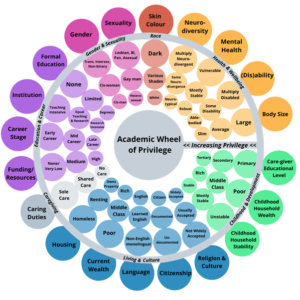Academic wheel of privilege
The Academic Wheel of Privilege is based on twenty identity types spanning seven categories: living and culture, caregiving, education and career, gender and sexuality, race, health and wellbeing and childhood and development. These identity types are shown as circles connected to three concentric rings (outer, middle and inner) of “identity” circles with increasing privilege as you go towards the centre. The effect of the concentric rings makes it appear like a funnel – the closer you get to the centre the more you’re likely to spiral into more privilege.
Reproduced under CC-BY Attribution 4.0 International from Elsherif, M. M., Middleton, S. L., Phan, J. M., Azevedo, F., Iley, B. J., Grose-Hodge, M., Tyler, S., Kapp, S. K., Gourdon-Kanhukamwe, A., Grafton-Clarke, D., Yeung, S. K., Shaw, J. J., Hartmann, H., & Dokovova, M. (2022). Bridging Neurodiversity and Open Scholarship: How Shared Values Can Guide Best Practices for Research Integrity, Social Justice, and Principled Education. MetaArXiv https://doi.org/10.31222/osf.io/k7a9p

